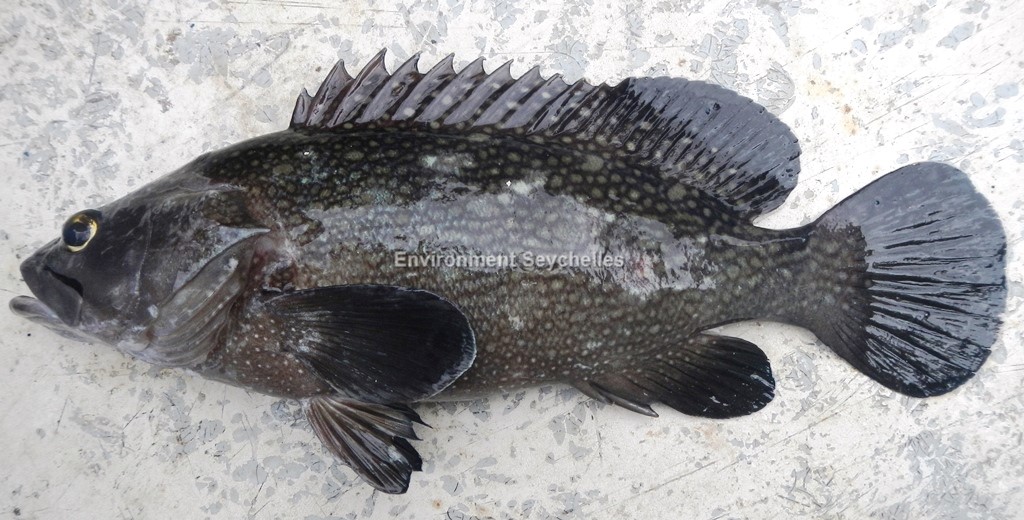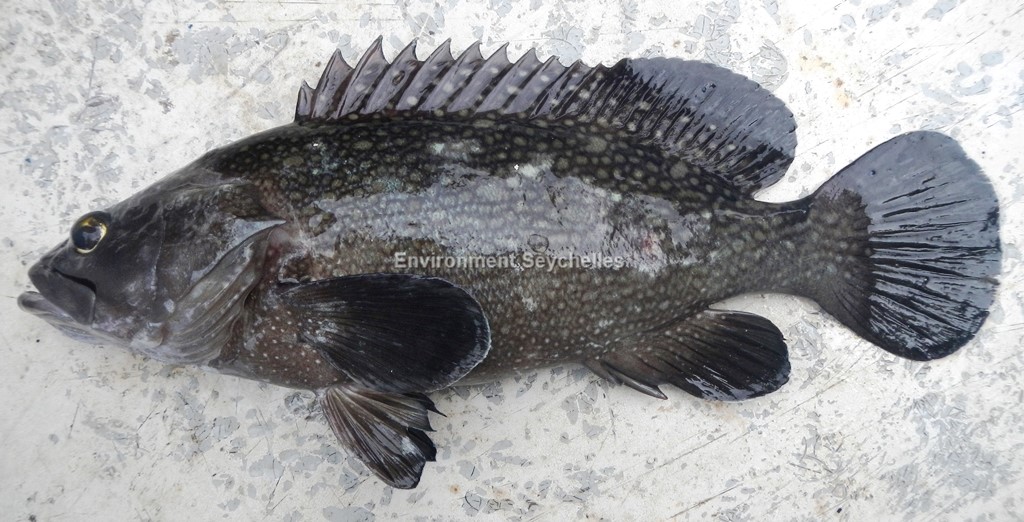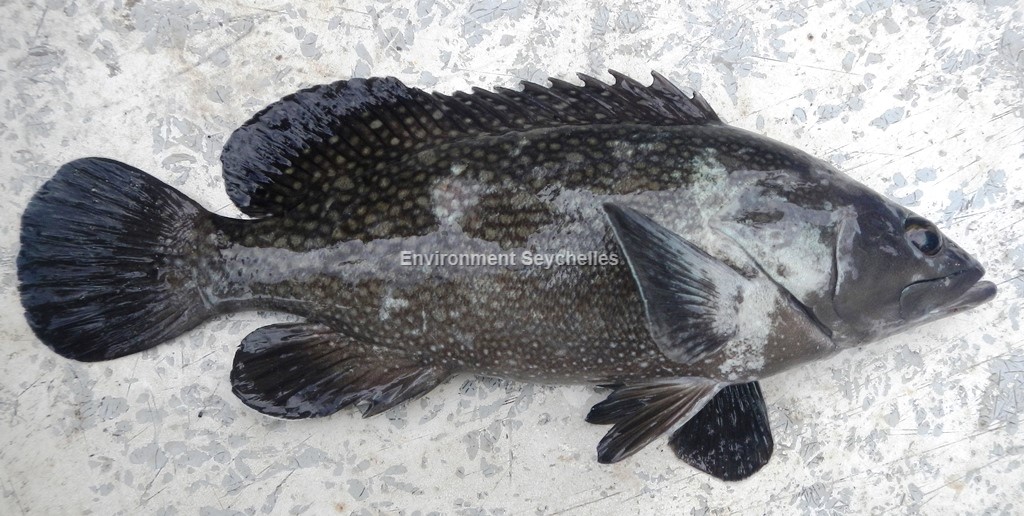Description:
Dorsal spines: 11; Dorsal rays: 14-16; Anal spines: 3; Anal rays: 8-9.
Moderately full-bodied grouper. Posterior nostril of adults vertically elongate. Maxilla extends to vertical at rear edge of eye. Serrae at the angle of the preopercle slightly
enlarged; the upper edge of the operculum strongly convex. Interspinous dorsal fin membranes incised. Caudal fin rounded.
Colour. Dark olive brown to dark brownish grey; head and body with large pale blotches and numerous small white spots overlying this pattern. Fins covered with small white
spots except for the pectoral fins with a white spots are usually confined to the base. Black maxillary streak. Blackish brown blotches are sometimes visible at the base of
the dorsal fin and on top of the peduncle. Juveniles dark grey, with large dark edged white spots of variable size on the head, body and fins.
Size:
Maturity: Lm unknown. Range unknown. Max Length: 52 cm TL. Common length 40 cm TL.
Habitat and Ecology:
Inhabits shallow protected coral reefs and shallow lagoons and seaward reef slopes (depth 1-30 m). Feeds on fishes and crustaceans.
Fishery Status:
This species is not protected or subject to fishery regulations. It is presumably caught in the handline and fish trap fisheries, but appears to be a very rare component of the catch.
Notes:
E. summana is similar in appearance to E. ongus. E. ongus has longer pectoral fins, longer pelvic fins and adults do not have vertically elongated posterior nostrils. E.
ongus has a narrow white margin and broad blackish submarginal band posteriorly on the median fins (these markings are absent or poorly developed in E. summana). The white
spots on adult E. ongus tend to coalesce posteriorly to form narrow wavy longitudinal stripes.
This species is typically considered as an endemic of the red Sea and Gulf of Aden. However other sources cite it as occurring in the Andaman Islands, China and even Palau.
The renowned ichthyologist JLB Smith recorded E. summana in Seychelles in the 1950s. It was not documented again however until this specimen in 2014.
References:
Craig, M.T. et al. (2011). Groupers of the World - a field and market guide. NISC (Pty) Ltd, South Africa. ISBN: 978-1-920033-11-8
Froese, R. & D. Pauly. (Eds.) (2019). FishBase. https://www.fishbase.se/summary/Epinephelus-summana.html (06/03/19).
Samoilys, M. (2018). Epinephelus summana. The IUCN Red List 2018: http://dx.doi.org/10.2305/IUCN.UK.2018-2.RLTS.T132728A100559239.en. (06/03/19).
Smith, J.L.B. & Smith, M.M. (1963). The Fishes of Seychelles. Department of Ichthyology. Rhodes University. Grahamstown.
Citation:
Nevill, J.E.G. (2019). Epinephelus summana, Summan grouper. Seychelles Seatizens. www.seatizens.sc. https://seatizens.sc/species/epinephelus-summana-forsskal-1775/ (edited 06/08/22).




pin up azerbaycan https://azerbaijancuisine.com/# pin up kazino
pin-up oyunu
https://northern-doctors.org/# mexico drug stores pharmacies
purple pharmacy mexico price list Mexico pharmacy that ship to usa medicine in mexico pharmacies
https://northern-doctors.org/# mexican online pharmacies prescription drugs
mexican online pharmacies prescription drugs: mexican pharmacy northern doctors – mexican mail order pharmacies
https://northern-doctors.org/# reputable mexican pharmacies online
mexican drugstore online: Mexico pharmacy that ship to usa – reputable mexican pharmacies online
https://northern-doctors.org/# mexican pharmacy
mexican pharmaceuticals online: northern doctors – mexican mail order pharmacies
https://northern-doctors.org/# mexican pharmacy
п»їbest mexican online pharmacies: northern doctors pharmacy – medication from mexico pharmacy
buying prescription drugs in mexico online mexican pharmacy online mexico drug stores pharmacies
https://northern-doctors.org/# buying from online mexican pharmacy
http://northern-doctors.org/# medication from mexico pharmacy
pharmacies in mexico that ship to usa: mexican pharmacy online – mexico pharmacies prescription drugs
pharmacies in mexico that ship to usa mexican pharmacy online mexican border pharmacies shipping to usa
http://northern-doctors.org/# mexican mail order pharmacies
pharmacies in mexico that ship to usa: mexican northern doctors – mexican drugstore online
http://northern-doctors.org/# mexican pharmacy
mexican mail order pharmacies: purple pharmacy mexico price list – mexican rx online
https://northern-doctors.org/# buying prescription drugs in mexico online
http://northern-doctors.org/# mexican pharmaceuticals online
pharmacies in mexico that ship to usa mexican northern doctors pharmacies in mexico that ship to usa
medication from mexico pharmacy: Mexico pharmacy that ship to usa – mexican border pharmacies shipping to usa
https://northern-doctors.org/# reputable mexican pharmacies online
https://northern-doctors.org/# mexican border pharmacies shipping to usa
http://northern-doctors.org/# buying prescription drugs in mexico online
best online pharmacies in mexico northern doctors pharmacies in mexico that ship to usa
http://northern-doctors.org/# mexican rx online
I appreciate the humor in your analysis! For additional info, visit: FIND OUT MORE. What do you think?
https://northern-doctors.org/# mexican pharmacy
medication from mexico pharmacy: Mexico pharmacy that ship to usa – mexican rx online
mexican mail order pharmacies: mexican northern doctors – mexico pharmacies prescription drugs
https://northern-doctors.org/# medicine in mexico pharmacies
mexican border pharmacies shipping to usa northern doctors buying from online mexican pharmacy
https://northern-doctors.org/# medicine in mexico pharmacies
mexican border pharmacies shipping to usa: mexican pharmacy – buying from online mexican pharmacy
https://cmqpharma.com/# mexico drug stores pharmacies
medicine in mexico pharmacies
buying prescription drugs in mexico online cmqpharma.com mexican pharmacy
best india pharmacy: top online pharmacy india – india pharmacy
canadian valley pharmacy: precription drugs from canada – medication canadian pharmacy
reputable indian pharmacies: Online medicine home delivery – india online pharmacy
canada drug pharmacy: best canadian online pharmacy – online canadian pharmacy
canada pharmacy online: pharmacy in canada – best online canadian pharmacy
reputable mexican pharmacies online: best online pharmacies in mexico – mexican pharmacy
http://indiapharmast.com/# buy medicines online in india
canadian pharmacy no scripts: canadian pharmacies comparison – reputable canadian pharmacy
Online medicine home delivery: world pharmacy india – online pharmacy india
pharmacy wholesalers canada real canadian pharmacy canadian pharmacy checker
mexico drug stores pharmacies: buying prescription drugs in mexico online – best online pharmacies in mexico
http://canadapharmast.com/# reliable canadian online pharmacy
п»їlegitimate online pharmacies india: india pharmacy mail order – indian pharmacies safe
buying from online mexican pharmacy: mexico drug stores pharmacies – medication from mexico pharmacy
canadian neighbor pharmacy: reliable canadian pharmacy reviews – 77 canadian pharmacy
http://clomiddelivery.pro/# get generic clomid tablets
http://doxycyclinedelivery.pro/# doxycycline 75 mg cost
https://amoxildelivery.pro/# how to get amoxicillin over the counter
how to get generic clomid for sale: order cheap clomid without a prescription – cost generic clomid no prescription
https://paxloviddelivery.pro/# paxlovid cost without insurance
п»їpaxlovid: paxlovid cost without insurance – paxlovid cost without insurance
https://paxloviddelivery.pro/# paxlovid buy
http://paxloviddelivery.pro/# paxlovid cost without insurance
paxlovid india: paxlovid india – Paxlovid over the counter
https://clomiddelivery.pro/# can i get cheap clomid without prescription
http://clomiddelivery.pro/# where to buy cheap clomid prices
purchase cipro: cipro ciprofloxacin – buy cipro online without prescription
http://amoxildelivery.pro/# amoxicillin 250 mg
buy ciprofloxacin: ciprofloxacin – buy cipro online
buy amoxicillin without prescription: amoxicillin 500 mg cost – can you buy amoxicillin over the counter canada